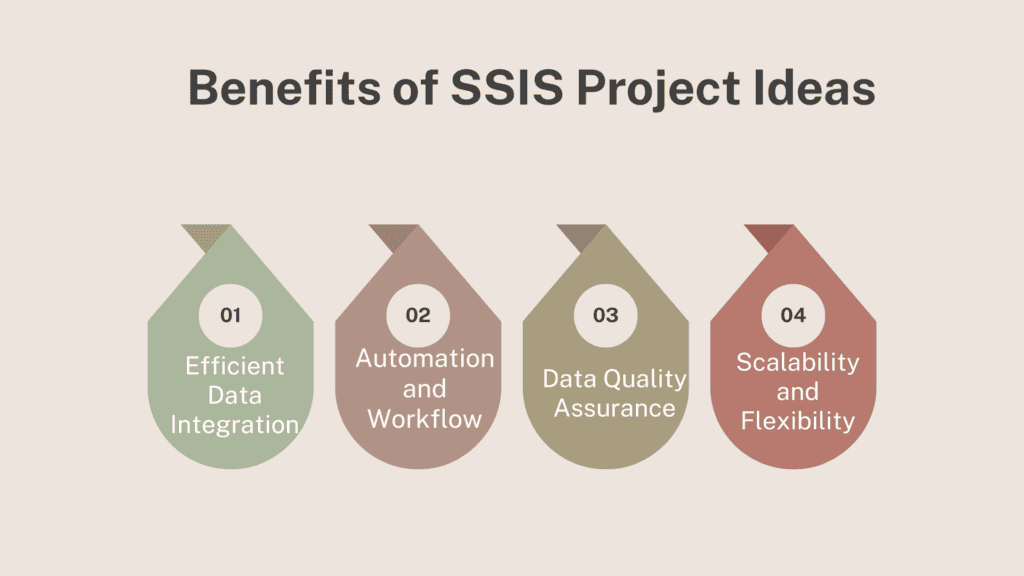Table of Contents
Key Takeaways
- SQL Server Integration Services (SSIS) is a powerful tool for data integration and transformation in SQL Server.
- SSIS projects can be used for a wide range of data integration tasks, such as extracting data from various sources, transforming and cleaning the data, and loading it into a target database.
- One project idea is to create an SSIS package for migrating data from one database to another, ensuring data consistency and integrity throughout the process.
- Another idea is to build an SSIS package for automating the extraction, transformation, and loading (ETL) process for a data warehouse, allowing for efficient and timely data updates.
- SSIS can also be used for real-time data integration, such as capturing and processing data from multiple sources in real-time, and updating a target database accordingly.
- Building an SSIS package for data cleansing and validation is another useful project idea, as it can help ensure data quality and accuracy in a database.
- SSIS projects can also be used for creating data integration solutions for specific industries or domains, such as healthcare, finance, or retail.
- It is important to plan and design SSIS projects carefully, considering factors such as data sources, data transformations, error handling, and performance optimization.
- SSIS provides a range of built-in components and tasks, as well as the ability to create custom components, allowing for flexibility and customization in project development.
- Regular testing, monitoring, and maintenance of SSIS projects are essential to ensure their ongoing performance and reliability.

Discover the power of SQL Server Integration Services (SSIS)! This versatile tool gives you the ability to integrate data from multiple sources, transform it, and load it into destination systems. Automate complex data integration tasks and save time for your organization.
Explore the endless possibilities of SSIS project ideas. Whether you’re a developer or a business analyst, you can benefit from this tool. Leverage event handling and message queuing techniques to create real-time data processing solutions. Tap into the potential of cloud computing with Azure Data Factory or Amazon Web Services.
Don’t miss out on this chance! Revolutionize your data integration processes with SSIS. Streamline operations, improve efficiency, and gain valuable insights from your data. Embrace the power of automation and the future of data integration with SSIS – making data integration less painful and more enjoyable than a root canal!
Overview of SQL Server Integration Services (SSIS)
SQL Server Integration Services (SSIS) is a powerful tool from Microsoft. It helps users to integrate and transform data from various sources. SSIS provides a platform for designing, building, and deploying data integration solutions that are both robust and scalable.
Key Features:
- Designing, Building, and Deploying Data Integration Solutions
- Handling Multiple Sources for Data Integration
- Robust and Scalable Platform
SSIS also has a range of built-in tasks and transformations. These allow developers to extract data from source systems, make changes to it, and load it into target systems. SSIS is easy to use with its graphical interface. This helps users to create complex workflows.
Another good thing about SSIS is that it can manage structured and unstructured data formats. This means people can integrate data from different sources, such as databases, Excel spreadsheets, XML files, web services, etc.
Let me share an interesting story of how SSIS helped a business. A retail company needed to bring together their sales data from stores across multiple regions in real-time. They used SSIS to create custom packages with the necessary transformations and validations. This automation improved the accuracy and performance of their sales reporting.
SSIS project ideas: explore how to make data do exactly what you want- it’s a great way to start the day!
Benefits of SSIS Project Ideas

SQL Server Integration Services (SSIS) projects provide multiple advantages for data integration and transformation. These advantages are creative and make data management projects more effective. Here are some of the benefits:
- Efficient Data Integration: SSIS projects make it easy to bring together multiple data sources without any trouble.
- Automation and Workflow: By using SSIS, boring tasks can be automated which reduces manual effort and improves workflow.
- Data Quality Assurance: SSIS projects help clean and validate data, increasing quality and reliability.
- Scalability and Flexibility: SSIS projects can be customized to fit changing business needs. Different data formats can also be handled.
To get the most out of SSIS projects, configuring and optimizing packages is essential to get the best performance.
Pro Tip: “Keep packages simple to make maintenance and trouble-shooting easier.”
It’s time to integrate and innovate with SSIS projects and say goodbye to dull data!
List of SQL Server Integration Services Project Ideas

Unlock the full potential of SQL Server Integration Services (SSIS) and its powerful capabilities! Get ready to explore a range of project ideas that you can develop using SSIS.
- Migrate data from one database to another, ensuring seamless transfer and accuracy.
- Create ETL (Extract, Transform, Load) processes to extract data from multiple sources, transform it and load it into a target database.
- Automate data warehouse updates with SSIS packages.
- Develop SSIS packages for data cleansing and validation tasks.
- Integrate various systems or databases in real-time with SSIS.
Explore advanced features like event handling, package configurations and script components to enhance your projects. There are endless possibilities for creating innovative solutions with SSIS.
Start your journey now and gain efficiency gains and improved decision-making with effective integration. It’s time to get your database dancing!
Examples and Descriptions of each project idea
Table of Examples and Descriptions for Project Ideas:
- Data Migration: Transfer data from one database to another with accuracy and integrity.
- ETL Process: Extract, transform, and load data from numerous sources into a single database.
- Real-time Analytics: Analyze streaming data continuously for immediate insights.
- Workflow Automation: Automate mundane tasks and streamline business processes using SSIS.
Now let’s dive deeper. For example, SSIS facilitates smooth data migration between databases with data quality checks and transformations.
As an example of implementation, there is an e-commerce company that employed SSIS for workflow automation. This enabled their order processing system to automate tasks like inventory updates, order status notifications, and customer data synchronization across different platforms. This reduced manual effort and improved efficiency, ultimately improving the customer experience.
Frequently Asked Questions
1. What are some interesting project ideas for SQL Server Integration Services (SSIS)?
There are numerous project ideas for SSIS, such as data migration, ETL (Extract, Transform, Load) processes, automated data imports/exports, real-time data integration, and building custom workflows.
2. Can you provide an example of a data migration project using SSIS?
Certainly! A data migration project using SSIS could involve transferring data from a legacy system to a new database. This can include mapping fields, handling data transformations, and ensuring data integrity during the transfer process.
3. How can I utilize SSIS for real-time data integration?
SSIS can be used to create data integration packages that continuously monitor and synchronize data among multiple systems in real-time. By configuring appropriate data sources, destinations, and transformation tasks, you can achieve real-time data integration with SSIS.
4. What kind of ETL processes can I develop with SSIS?
With SSIS, you can build complex ETL processes for data extraction, transformation, and loading. This includes tasks like data cleansing, data validation, data enrichment, and data aggregation to prepare data for reporting or analysis.
5. Are there any resources available for learning SSIS project development?
Yes, there are various online tutorials, documentation, and video courses that can help you learn SSIS project development. Microsoft provides official documentation and there are many community-driven resources available on platforms like Stack Overflow and SQL Server forums.
6. How can I create custom workflows using SSIS?
SSIS allows you to create custom workflows by utilizing control flow tasks such as conditional execution, looping, and event handling. These tasks can be combined and arranged to design custom workflows that suit your specific project requirements.
Conclusion
When designing an SSIS project, keep scalability and performance optimization in mind from the start. Use parallel execution to split the package into multiple tasks that can run simultaneously. This reduces execution time. Checkpoints let you resume a package from where it left off in case of any interruptions or failures.
Also, implement error handling and logging. Capture and log errors for easy troubleshooting and improved data quality. Set up notifications to receive alerts when specific conditions or events occur during package execution.
Finally, take advantage of SSIS’s ability to integrate with other technologies and systems. Connect to cloud platforms like Azure or integrate with external APIs for seamless integration of various data sources and applications.
References:
SQL Server Integration Services Project Ideas
SQL Server Integration Services Project Ideas
Also Read: